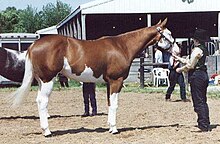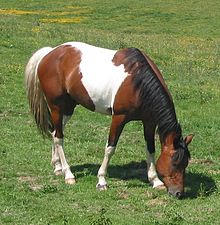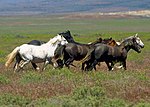
Roan is a coat color found in many animals, including horses, cattle, antelope, cat and dogs. It is defined generally as an even mixture of white and pigmented hairs that do not "gray out" or fade as the animal ages. There are a variety of genetic conditions which produce the colors described as "roan" in various species.

The American Paint Horse is a breed of horse that combines both the conformational characteristics of a western stock horse with a pinto spotting pattern of white and dark coat colors. Developed from a base of spotted horses with Quarter Horse and Thoroughbred bloodlines, the American Paint Horse Association (APHA) breed registry is now one of the largest in North America. The registry allows some non-spotted animals to be registered as "Solid Paint Bred" and considers the American Paint Horse to be a horse breed with distinct characteristics, not merely a color breed.

Lethal white syndrome (LWS), also called overo lethal white syndrome (OLWS), lethal white overo (LWO), and overo lethal white foal syndrome (OLWFS), is an autosomal genetic disorder most prevalent in the American Paint Horse. Affected foals are born after the full 11-month gestation and externally appear normal, though they have all-white or nearly all-white coats and blue eyes. However, internally, these foals have a nonfunctioning colon. Within a few hours, signs of colic appear; affected foals die within a few days. Because the death is often painful, such foals are often humanely euthanized once identified. The disease is particularly devastating because foals are born seemingly healthy after being carried to full term.

A piebald or pied animal is one that has a pattern of unpigmented spots (white) on a pigmented background of hair, feathers or scales. Thus a piebald black and white dog is a black dog with white spots. The animal's skin under the white background is not pigmented.
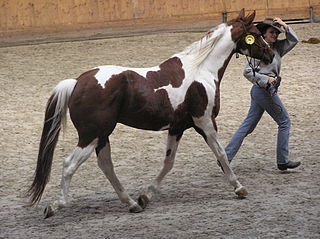
Skewbald is a colour pattern of horses. A skewbald horse has a coat made up of white patches on a non-black base coat, such as chestnut, bay, or any colour besides black coat. Skewbald horses which are bay and white are sometimes called tricoloured. These horses usually have pink skin under white markings and dark skin under non-white areas. Other than colour, it is similar in appearance to the piebald pattern. Some animals also exhibit colouration of the irises of the eye that match the surrounding skin. The underlying genetic cause is related to a condition known as leucism. The term is also used to describe spotting patterns in various other animals, such as goats.

Tri-coloured refers to a horse with three different coat colours in a pinto spotting pattern of large white and dark patches, usually bay and white. This colouring is also commonly called skewbald. In modern usage in British English, skewbald and piebald horses are collectively referred to as coloured, while in North American English, the term pinto is used to describe the colour pattern.
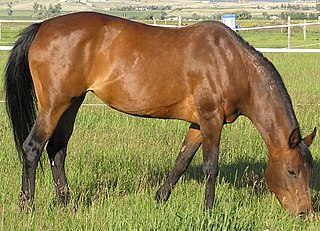
Bay is a hair coat color of horses, characterized by a reddish-brown or brown body color with a black point coloration on the mane, tail, ear edges, and lower legs. Bay is one of the most common coat colors in many horse breeds.

A pinto horse has a coat color that consists of large patches of white and any other color. Pinto coloration is also called paint, particolored, or in nations that use British English, simply coloured. Pinto horses have been around since shortly after the domestication of the horse.
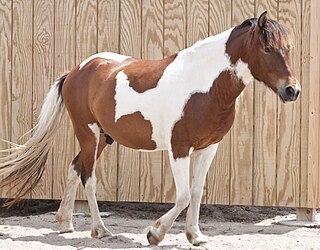
Tobiano is a spotted color pattern commonly seen in pinto horses, produced by a dominant gene. The tobiano gene produces white-haired, pink-skinned patches on a base coat color. The coloration is almost always present from birth and does not change throughout the horse's lifetime, unless the horse also carries the gray gene. It is a dominant gene, so any tobiano horse must have at least one parent who carries the tobiano gene.
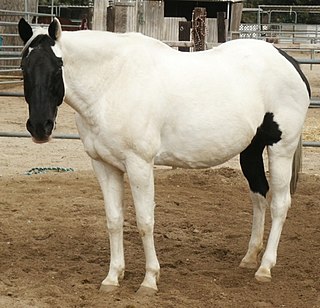
The Tovero coloration is a mix of tobiano and overo colorations in Pinto horses and American Paint Horses. The genetics of pinto coloration are not always fully understood, and some horses have a combination of patterns that does not fit cleanly in either category.

Horses exhibit a diverse array of coat colors and distinctive markings. A specialized vocabulary has evolved to describe them.

A white horse is born predominantly white and stays white throughout its life. A white horse has mostly pink skin under its hair coat, and may have brown, blue, or hazel eyes. "True white" horses, especially those that carry one of the dominant white (W) genes, are rare. Most horses that are commonly referred to as "white" are actually "gray" horses whose hair coats are completely white. Gray horses may be born of any color and their hairs gradually turn white as time goes by and take on a white appearance. Nearly all gray horses have dark skin, except under any white markings present at birth. Skin color is the most common method for an observer to distinguish between mature white and gray horses.

Sabino describes a distinct pattern of white spotting in horses. In general, Sabino patterning is visually recognized by roaning or irregular edges of white markings, belly spots, white extending past the eyes or onto the chin, white above the knees or hocks, and "splash" or "lacy" marks anywhere on the body. Some sabinos have patches of roan patterning on part of the body, especially the barrel and flanks. Some sabinos may have a dark leg or two, but many have four white legs. Sabino patterns may range from slightly bold face or leg white markings—as little as white on the chin or lower lip—to horses that are fully white.
The American Paint Horse Association (APHA) is a breed registry for the American Paint Horse. It is currently headquartered in Fort Worth, Texas. It was founded in 1965 with the merging of two different color breed registries that had been formed to register pinto-colored horses of Quarter Horse bloodlines. One of these organizations was the American Paint Quarter Horse Association and the other was the American Paint Stock Horse Association.
A cropout, crop-out or crop out is a horse with body spots, including pinto or leopard complex spotting, or "high white" horse markings, with a sire and dam who both appeared to have been solid-colored. There are several variations in the definition, depending on the breed registry involved. There are multiple genetic reasons that may cause a horse to be a cropout. Sometimes solid-colored horses throw cropouts because some spotting patterns are recessive genes that are not necessarily expressed unless the relevant allele is inherited from both parents. Other times a gene may be a dominant or incomplete dominant but so minimally expressed that the horse looks solid but can pass flashy color on to its offspring.

Splashed white or splash is a horse coat color pattern in the "overo" group of spotting patterns that produces pink-skinned, white markings. Many splashed whites have very modest markings, while others have the distinctive "dipped in white paint" pattern. Blue eyes are a hallmark of the pattern, and splash may account for otherwise "solid" blue-eyed horses. Splashed white occurs in a variety of geographically divergent breeds, from Morgans in North America to Kathiawari horses in India. The splashed white pattern is also associated with congenital deafness, though most splashed whites have normal hearing. Splashed white can be caused by multiple variants across two different genes, for which genetic testing is available.

Dominant white (W) is a group of genetically related coat color alleles on the KIT gene of the horse, best known for producing an all-white coat, but also able to produce various forms of white spotting, as well as bold white markings. Prior to the discovery of the W allelic series, many of these patterns were described by the term sabino, which is still used by some breed registries.
The Pinto Horse Association of America (PtHA) registers horses, utility horses, ponies and miniature horses of various pedigrees with certain kinds of pinto coat colors. The word pinto is Spanish for "paint." In general terms, pinto can apply to any horse marked with unpigmented pink-skinned, white-haired areas on its coat. The Pinto Horse Association of America provides the owners and riders of pintos with a show circuit and a breed organization. The primary requirement for PtHA registration is coat color; the pinto is not a true breed, but a color breed.

Roan is a horse coat color pattern characterized by an even mixture of colored and white hairs on the body, while the head and "points"—lower legs, mane, and tail—are mostly solid-colored. Horses with roan coats have white hairs evenly intermingled throughout any other color. The head, legs, mane, and tail have fewer scattered white hairs or none at all. The roan pattern is dominantly inherited, and is found in many horse breeds. While the specific mutation responsible for roan has not been exactly identified, a DNA test can determine zygosity for roan in several breeds. True roan is always present at birth, though it may be hard to see until after the foal coat sheds out. The coat may lighten or darken from winter to summer, but unlike the gray coat color, which also begins with intermixed white and colored hairs, roans do not become progressively lighter in color as they age. The silvering effect of mixed white and colored hairs can create coats that look bluish or pinkish.

Ann Trommershausen Bowling was an American scientist who was one of the world's leading geneticists in the study of horses, conducting research in the areas of molecular genetics and cytogenetics. She was a major figure in the development of testing to determine animal parentage, first with blood typing in the 1980s and then DNA testing in the 1990s. She later became known for her studies of hereditary diseases in horses and equine coat color genetics, as well as research on horse evolution and the development of horse breeds. She studied the population genetics of feral horses, did considerable work to help preserve the Przewalski's horse, and was one of the founding members of the international project to map the horse genome. She was an adjunct professor at the University of California, Davis (UCD), and at the time of her death in 2000 was the executive associate director of the Veterinary Genetics Laboratory (VGL) there. Her unexpected death on December 8, 2000, at age 57 was attributed to a massive stroke.


